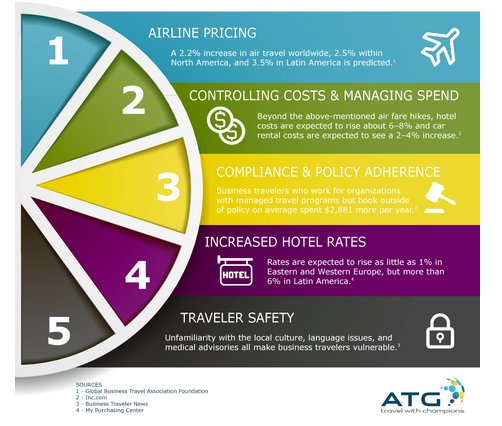Did you know these corporate travel facts?
- On average, companies spent more than 10% of their total annual budget on expenses related to business travel in 2014, according to Aberdeen.
- Non-compliance with corporate travel policies is a top-three challenge for 57% of executives surveyed by Travelport.
- Nearly 85% of respondents to the Travelport survey say rising airfares and hotel rates have negatively affected their corporate travel programs.
One of my favorite things in life is to travel and to explore new places. It’s inspiring and gives me perspective on different regions and lifestyles. That said, business travel can be a far cry from leisure travel.
It’s great to meet customers and partners, and I enjoy dinners with colleagues on the road. But when I travel, my work week gets jumbled by the diversion from my routine. Time changes, the lack of veggies in my diet, and missing my oh-so-comfy bed. There are times when we all have to meet in person. But business travel sometimes exacts a high cost from project deadlines and time-sensitive work.
Honestly, and I know I am not alone, spending time in security checkpoints, then sitting on a plane for hours trying to get comfortable and be productive can be a nuisance.
Travel itself is expensive. And it’s more expensive when you factor in the unexpected elements such as missed connections, cancelled flights, or lost luggage. Each year, business travel mishaps amount to out-of-pocket expenses of $1,475 per employee plus an average of 2.3 work days lost, according to Global Business Travel Magazine.
Reduce Travel without Reducing Relationships
Business travel is a necessity and often beneficial, but implementing collaboration technologies can provide alternatives to travel, reducing financial and productivity costs.
According to a survey by the Business Travel Show, the top concerns for corporate travel managers are: airline pricing, cost control and spending management, compliance and policy adherence, increased hotel rates, and traveler safety.
Top 5 Concerns for Global Travel Buyers in 2015:
When considering how collaboration technologies can benefit your business objectives think about these three areas:
- Reduce travel expenses
- Increase employee engagement and productivity
- Support environmental sustainability efforts
According to Air Transport Action Group, Worldwide, flights produced 705 million tons of CO2 in 2013 – accounting for 12% of CO2 emissions from all transport sources.
Think mobility, mobility, mobility… and not just physically, but virtually. Imagine transporting yourself effortlessly, instantly, and without delays. Plus you’re decreasing your carbon footprint.
Here are a few collaboration use cases that provide alternatives to business travel:
Incorporate Video into Meetings: Replace some travel with video conferencing. Meet face-to-face without geographical restraints other than time zones. Web conferencing keeps employees connected and available to meet anytime from anywhere.
Enable Meetings with Remote Attendees: Let people connect with external organizations in real time. WebEx and collaboration tools allow people to connect using their own devices with high-quality audio, video, and content sharing.
Support Teleworkers and Branch Offices: Being a teleworker myself, it’s important to feel connected to colleagues without frequent travel. The ability to connect remotely to locations is crucial to my productivity. I stay connected with my peers by meeting over video and have access to the same resources as my teammates who work in our offices.
Deliver Online Events and Training: Think about the growth of your business and your employees. Replace in-person training with compelling online learning experiences that support remote attendance. Instead of having to travel to sit in a classroom, let people access classes when it’s convenient. Help them stay productive. Informed and knowledgeable employees are more engaged and better primed to support your success.
Collaboration, growth, and environmental sustainability are key factors when analyzing business travel spending and policies. Learn more about how your teams can do business through video and collaboration tools instead of airports.


Excellent Summary – thanks for sharing
The focus for me is about what the best engagement can be – this will have an impact on reducing costs, but for me that isnt a primary driver